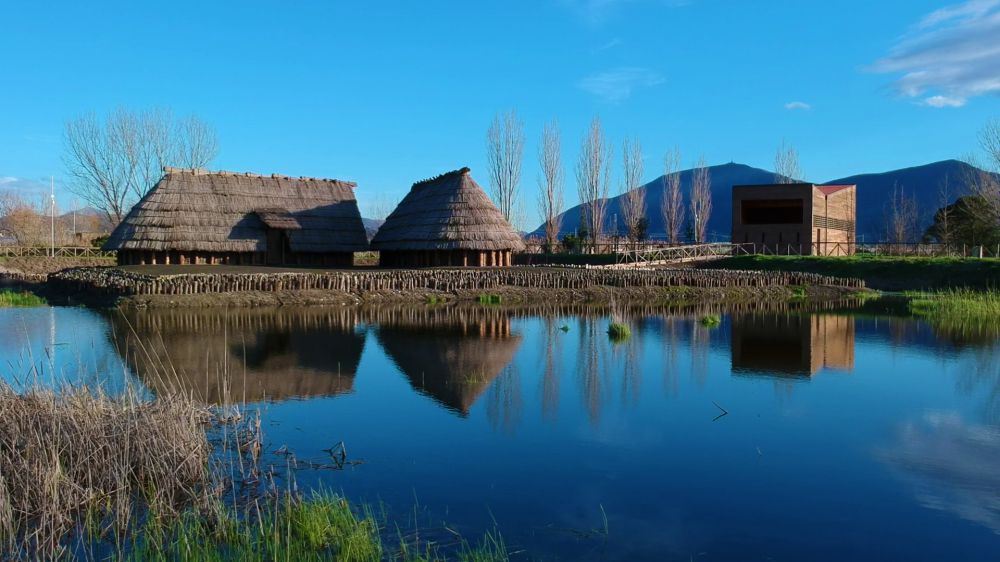Until a few decades ago, characteristic wooden boats, used for fishing and cane harvesting, plied the waters of the Sarno river.

Other boats sailed on that same river 3500 years ago, when the Sarrasti, mentioned by Virgil in the VII book of the Aeneid, settled in the Sarno valley. The identification of their origin is not univocal: it could have been an indigenous lineage, but there are those who identify a tribe of the Pelasgians, originally from the Pelopponnesos, where there was a river called Saron. The new population made its appearance in the Middle Bronze Age and settled in various areas of southern Italy, including the large valley formed by the Sarno.
That river to which they gave the name that still identifies it, in addition to being a fundamental route of transport and communication, also became their living environment. In fact, they built a river port and founded a village on stilts, which came to host a community of a few hundred people. The settlement developed on artificial islands, with oak wood pilings driven into the marshy ground, supporting stilts on which large reed huts were raised. Among the islets, to connect the various structures and, therefore, their inhabitants, canals opened up, which were crossed by flat-bottomed wooden pirogues. All around, nature dominated with dense woods, especially oaks, populated by numerous species of wild animals.
The inhabitants of the village, since the most ancient phase, had relationships with the East and Northern Europe, evidenced by the necklaces of very precious amber, which were found together with fibulae, ceramic objects, amulets and glass paste jewellery. In addition to the wooden tools used for agricultural work, all very well preserved. Like the three pirogues brought to light in the excavation campaigns that took place in Longola, in the municipality of Poggiomarino, since 2000, when the first traces of the ancient, hitherto unknown village were identified. A unique example of extraordinary archaeological interest, re-emerged during the construction of one of the plants intended for the purification of the waters of the Sarno. Since then, archaeological research has revealed the remains and reconstructed the history of that very particular site, inhabited from the 15th to the 6th century BC, when the descendants of the Sarrasti merged with the Samnites, who were rapidly expanding in the Sarno area.
After ten centuries of life, the village was completely abandoned following progressive depopulation, caused by the choice of sites, always in the same area, more favorable to the development of commercial relations with other nearby populations. Therefore, the end of the village of Longola may have played a fundamental role in the origin of two cities destined to become among the largest and most powerful in ancient Campania: the coastal Pompeii and the more internal Nucera Alfaterna, corresponding to the current Nocera Inferiore and Nocera Superiore, which preserve significant testimonies.
The reconstruction of the huts in the archaeological Park
After the archaeological discovery at the beginning of the millennium and in light of what emerged from the subsequent excavation campaigns led by the archaeologist Claude Albore Livadie, the original project for the construction of a purification plant was replaced by one for the protection and valorisation of the archaeological area created by the Municipality of Poggiomarino. Thus, starting from 2013, the Longola naturalistic archaeological Park was born. It occupies a vast area adjacent to the one in which excavations and archaeological investigation activities are still underway. The park area was previously the subject of an environmental restoration action, favoring the reconstitution of the rich and varied plant heritage that characterized the site and the landscape already at the time of the ancient river village.
The nature itinerary also draws value from the attendance of various species of birds, both sedentary and migratory, and is therefore suitable for birdwatching. Part of the village was then rebuilt, life-size, with huts for residential use on stilts surrounded by navigable canals as happened in ancient times. An itinerary of great charm, equipped with services for use, with spaces dedicated to reception accompanied by educational and information aids, including multimedia.
Hours and info:
From Monday to Saturday from 9:00 to 13:00 - Sunday closed
+39 081 865 81 11



Comments powered by CComment